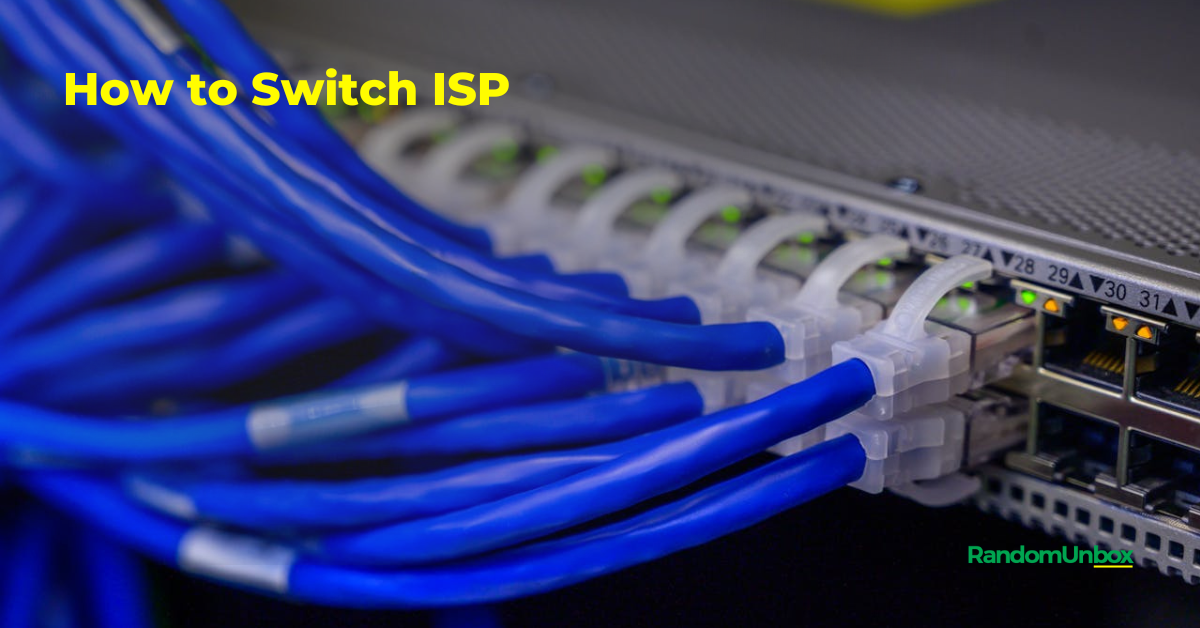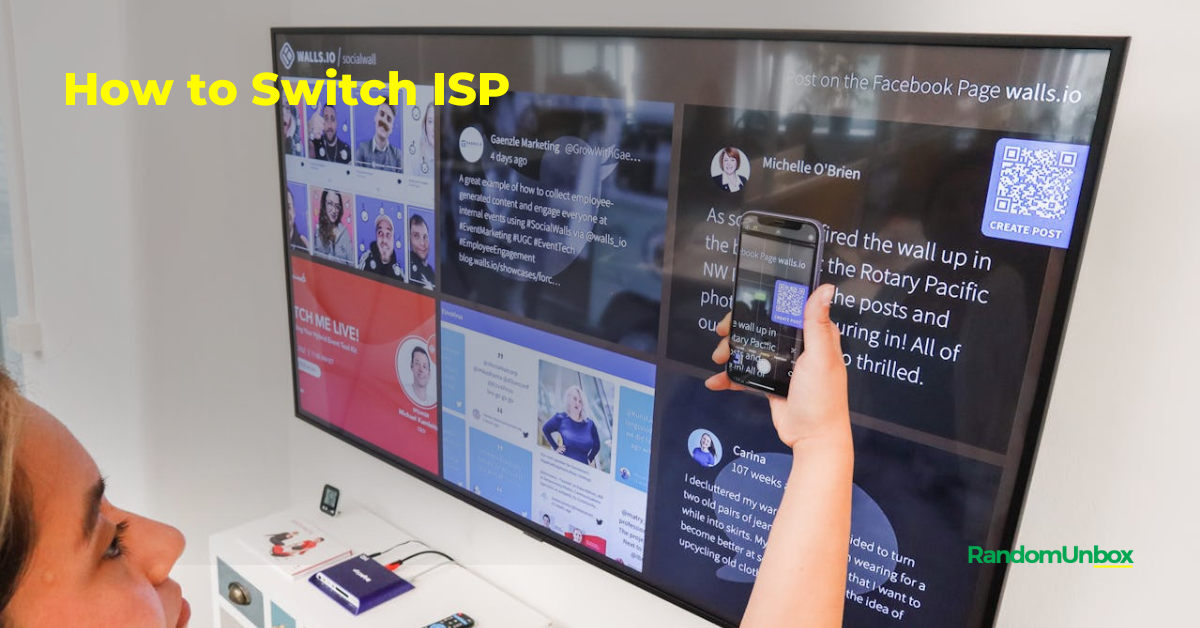Do you ever feel like your internet connection is more of a hindrance than a help? Slow loading times, frustrating buffering, and dropped connections can quickly turn online activities into an exercise in patience.
Fortunately, you don’t have to settle for sluggish internet. Switching internet service providers (ISPs) can be a simple and effective way to experience significant improvements. Not only can you potentially access faster speeds and more reliable connections, but you might also find more affordable plans and enhanced customer service.
Let’s explore the potential benefits of switching ISPs and guide you through the process of finding the perfect provider for your needs.
Switching Internet Providers
Making the switch to a new Internet Service Provider (ISP) can be a smart move, but careful planning is key to a smooth transition. Here’s a breakdown of the process in five easy-to-follow steps:
1. Research and Compare:
- Start by exploring ISP options available in your area. Consider factors like speed, data caps, pricing, and customer reviews when comparing plans. Online resources and comparison websites can be helpful tools for this step.
2. Understand Your Current Contract:
- Review your existing contract with your current ISP. This will help you determine any early termination fees you might incur if you cancel before the contract ends.
3. Communicate Clearly:
- Contact your current ISP to express your intention to switch providers. This allows them to initiate the cancellation process and answer any questions you may have.
4. Schedule Installation:
- Once you’ve chosen a new ISP, schedule installation for your new internet service. Ideally, schedule this after your current service is scheduled to end to minimize downtime.
5. Return Equipment (if applicable):
- If you rented equipment from your previous ISP, return it according to their instructions. This might involve returning it to a physical location or arranging a pick-up.
By following these steps and planning ahead, you can ensure a smooth and efficient transition to your new ISP.
Additional Tips:
- Consider using a bring-your-own-equipment (BYOE) option if your new ISP allows it. This can potentially save you money on equipment rental fees.
- Double-check all fees and charges associated with both the new and old ISPs. This includes installation fees, early termination fees, and any equipment rental costs.
By being proactive and informed, you can make the switch to a new ISP a positive experience.
Assess Your Needs:
1. Analyze Your Usage:
- Streaming: Do you enjoy watching movies, TV shows, or live sports online? This requires consistent bandwidth for smooth playback.
- Gaming: Online gaming demands low latency (response time) and reliable speed for a seamless experience.
- Downloads: Frequent file downloads, like large software updates or high-resolution videos, require significant bandwidth.
2. Speed Check:
- Knowing your download and upload speed needs is crucial. Check online speed tests to gauge your current internet speed.
- Higher download speeds are essential for streaming, downloading, and online gaming.
- Upload speeds become important for activities like video conferencing or uploading large files.
3. Beyond Speed:
- Data Caps: Some plans impose data usage limits. If you frequently download or stream, consider unlimited data plans to avoid additional charges.
- Bundled Services: Many providers offer bundled packages that combine internet with phone and TV services. Consider your overall needs to find the most cost-effective option.
- Equipment Needs: Ensure your internet plan is compatible with your existing equipment (router, modem) or factor in potential equipment rental costs.
By taking the time to assess your internet usage needs, you’ll be well-equipped to make informed decisions when choosing an internet service provider.
Researching New ISPs
Explore Your Internet Service Provider Options:
- Dive into plan details: Utilize online comparison tools to effortlessly compare different internet service providers (ISPs). These tools allow you to visualize plan options, prices, and features side-by-side, facilitating an informed decision.
- Go deeper: For comprehensive plan details and special offers, visit the individual websites of the ISPs you’re considering. This allows you to delve deeper into specific plan inclusions and any ongoing promotions that might benefit you.
- Know your options: Depending on your location, explore the different types of internet connections available: local, fiber optic, satellite, or cable internet. Each type offers varying availability, speeds, and price points.
- Listen to others: Before making a decision, take the time to read customer reviews and ratings online. This provides valuable insights into real-world user experiences, helping you gauge the overall reliability and customer service of each ISP.
-
Matching your budget: Beyond speed, compare pricing structures carefully. Look beyond the monthly cost and consider installation fees, equipment rentals, and potential bundle discounts that might combine internet service with phone or television packages.
-
Evaluating your options: Choosing a new internet service provider (ISP) can feel overwhelming, but a little research can go a long way. Begin by utilizing a zip code search tool to discover providers serving your area. Once you have a list, it’s time to compare plans based on three key factors: speed, price, and features.
By following these steps, you can effectively research and select the ISP that best suits your needs and budget.
Cancelling Current Service
Talk to Your Current ISP:
Before switching providers, consider these key points:
1. Understand your current contract:
- Review your contract terms: Know the duration of your contract, any data usage limitations, and potential early termination fees. This information helps you weigh the cost of switching providers.
2. Negotiate a better deal (optional):
- Contact your current ISP’s customer service: Explain your situation and inquire about available plans that better suit your needs and budget. You might be surprised by the deals they offer to retain customers.
3. Equipment return and fees:
- Confirm the process for returning their equipment: Ask about any fees associated with returning equipment, such as modems or routers. Some providers waive these fees if you return the equipment within a specific timeframe.
By following these steps, you can make an informed decision about switching internet providers and potentially save money or improve your service.
Signing up With New Provider
1. Choose the Right Plan:
Start by selecting an internet plan that perfectly matches your needs and budget. Consider factors like:
- Internet Speed: Choose a speed that supports your online activities, like streaming, gaming, or video conferencing.
- Data Usage: Estimate your monthly data usage to avoid exceeding data caps and incurring additional charges.
- Additional Features: Explore bundled features like phone service, TV packages, or equipment rental options.
2. Schedule Your Installation:
Once you’ve chosen your plan, schedule a convenient date and time for professional installation of your internet service. Many ISPs offer flexible scheduling options to accommodate your busy life.
3. Equipment Options:
Review your chosen plan’s details regarding equipment rental fees or purchase options. Some ISPs include equipment with the plan, while others offer it for rent or purchase separately. Choose the option that best fits your financial preference and long-term needs.
By following these simple steps, you can seamlessly sign up with your new ISP and start enjoying your internet connection.
Ensure a Seamless Transition!
Planning a smooth transition to a new internet service provider (ISP)? Here are three key steps to avoid disruptions and ensure a seamless experience:
1. Disconnect the old service after the new one is active:
- Crucially, schedule the disconnection of your old internet service only after your new service is up and running. This avoids any unwanted downtime and ensures you always have an active internet connection.
- Coordinate with both your new and old ISPs to confirm installation and disconnection dates.
2. Return old ISP equipment promptly:
- Ensure the timely return of any rented equipment, such as modems and routers, to your previous ISP.
- Follow their specific instructions for returning the equipment, usually involving a pre-paid shipping label or designated drop-off locations.
- Meeting the return deadline is crucial to avoid additional charges.
3. Prepare for a brief service interruption:
- Be aware that switching ISPs may involve a short period of downtime during the transition.
- This is typically minimal, but plan your activities accordingly to avoid any inconveniences.
By following these steps, you can ensure a smooth and hassle-free transition to your new internet service provider.
Frequently Asked Questions
How Do I Switch From One ISP to Another?
When considering switching ISPs, it is crucial to compare plans, research options, read customer reviews, evaluate installation processes, assess customer service, review contract details, test speeds, ensure router compatibility, check tech support availability, and compare pricing.
How Do I Change My ISP Provider?
When considering changing your ISP provider, ensure to compare prices, customer reviews, installation process, speeds, contract terms, customer service, modem compatibility, data usage, bundle options, and availability in your area. Research thoroughly to make an informed decision.
Do You Need to Cancel ISP Before Switching?
When considering switching Internet Service Providers (ISPs), it is essential to cancel your current ISP to avoid billing overlaps, return any rented equipment, terminate contracts, and smoothly transfer services. Contact customer service for guidance on this process.
How Does Switching ISPs Work?
When considering a switch between Internet Service Providers (ISPs), thorough comparison of services, contract termination, transfer process, service availability, customer feedback, installation, equipment return, technical support, billing transition, and speed testing are essential components for a successful transition.
Conclusion
Streamlining Your Internet Service:
Switching internet service providers (ISPs) can seem daunting, but with careful planning, it can be a smooth transition. Here’s a quick recap of the key steps:
- Explore your options: Research ISPs available in your area, comparing plan details like speed, data allowance, and cost.
- Evaluate your needs: Analyze your internet usage habits to determine the ideal speed and data allowance for your household.
- Scrutinize contracts: Read the fine print of potential plans, paying close attention to contract terms, early termination fees, and equipment rental costs.
- Schedule the switch: Coordinate installation of your new service with the termination of your existing plan to minimize downtime.
- Return equipment: Ensure the timely return of any rented equipment from your previous ISP to avoid additional charges.
Finding the Perfect Fit:
Choosing the right internet plan is crucial for a seamless online experience. Selecting a plan that aligns with your specific needs ensures you don’t overpay for features you don’t utilize or experience performance limitations that hinder your browsing, streaming, or gaming activities.
Empowered Decision-Making:
Investing time in researching and comparing various ISP offerings empowers you to make an informed decision. By carefully considering your needs and budget, you can choose the internet plan that best suits your requirements and delivers optimal value.
Remember: Don’t hesitate to reach out to customer service representatives at different ISPs for clarification and assistance throughout your search.










